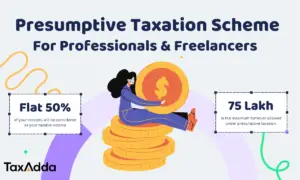Provisions of this page applicable for F.y 2016-17 (Assessment year 2017-18)
Persons for whom it is mandatory to file Income Tax Return
The following persons are mandatorily required to file income tax return
- Company
- Firm (In Income Tax Act Firm means a Partnership Firm, Sole proprietor firms are considered as an individual)
- Any other person whose total income exceeds the maximum amount which is not chargeable to income tax.
- A person is required to file ITR if total income of any other person in respect of which he is assessable under this Act during the previous year exceeded the maximum amount which is not chargeable to income-tax.
Maximum amount which is not chargeable to tax means the amount up to which no tax is payable as per income tax slabs.
Any person can file income tax return voluntarily.
Last date for filing Income Tax Return (ITR)
| Particulars | Due Date |
| 1. For such corporate assessees which is required to furnish a report under section 92E of Income Tax Act, 1961. | 30th November of the assessment year. |
| 2. For all corporate assessees | 30th September of the assessment year. |
| 3. For all non corporate assessees whose accounts are required to audit under section 44AB or under any other law for the time being in force. | 30th September of the assessment year. |
| 4. For working partners of partnership firms whose accounts are required to be audited under this Act or under any other law for the time being in force. | 30th September of the assessment year. |
| 5. For any other assessee. | 31st July of the assessment year. |
Also Read:
Benefits of filing tax return on time
Penalty on Late filing of Income tax return
Documents required to file ITR
Last date up to which ITR can be filed (Belated Return)
The income tax return can be filed up to the end of one year from the end of assessment year. Although a penalty of Rs. 5,000 under section 271F is levied if the return is filed after end of assessment year. For eg- ITR for financial year 2016-17 can be filed up to 31st March 2019 but a penalty of Rs. 5,000 is levied if return is filed after 31st March 2018.
Persons who can file ITR in Paper Form
All ITR forms have to be filed electronically. The only exception is the individual who is super senior citizen and whose income does not exceed Rs. 5 lakh and who has not claimed any refund in the return of income and who furnishes the return in Form No. SAHAJ ITR-1 or Form No. SUGAM (ITR-4).
Super senior individual is a person who is resident in India and is of age of 80 years or more at any point of time in the previous year. Check our calculator for assessing your status of senior or super senior citizen. Such person can file return in paper form.
Persons are mandatorily required to file income tax return through Digital Signature Certificate (DSC):-
- Individual or HUF whose accounts are required to be audited under section 44AB of the Act.
- All company whether public or private, domestic or foreign.
- A political party who required to furnish return in ITR-7.
- Firm or LLP or any person whose accounts are required to be audited under section 44AB of the Act.
All persons other than mentioned above can submit return in any of the following manner
- Electronically under digital signature
- Transmitting the data in the return electronically under electronic verification code
- Transmitting the data in the return electronically and thereafter submitting the verification of the return in Form ITR-V
Also Read – How to E-verify Income Tax Return , How to check ITR-V Receipt Status
Details to be included mandatorily in ITR
It is now mandatory to include Aadhar number/ Aadhar Enrollment Id in income tax return. Cash deposits of more than Rs. 2 lakhs made during demonetisation period is also needs to be included.
If the individual or HUF is filing ITR-2 and has income of more than Rs. 50 lakhs then he has to declare their assets and liabilities at the end of fiscal year in Schedule AL.
Also Read – 8 mistakes people do while filing Income Tax Return (ITR)
Forms for Filing ITR
| ITR Form | Who can file | Conditions | Income Tax Department’s Guide |
| ITR-1 (Sahaj) | Individual | This Return Form is to be used by an individual whose total income includes:- (a) Income from Salary/ Pension (b) Income from One House Property (excluding cases where loss is brought forward from previous years) (c) Income from Other Sources (excluding Winning from Lottery and Income from Race Horses and persons who has loss under this head) NOTE – Further, in a case where the income of another person like spouse, minor child, etc. is to be clubbed with the income of the assessee, this Return Form can be used only if the income being clubbed falls into the above income categories. This Return Form should not be used by an individual whose total income for the year includes:- (a) Income from more than one house property (b) Income from Winnings from lottery or income from Race horses (c) has total income, exceeding fifty lakh rupees; (d) Agricultural income in excess of 5,000 (e) has income taxable under section 115BBDA, 115BBE (f) Loss under the head ‘Income from other sources’ (g) Person claiming relief under section 90 or 90A and/or 91 (h) Any resident having any asset (including financial interest in any entity) located outside India or signing authority in any account located outside India (i) Any resident having income from any source outside India | View |
| ITR-2 | Individual & HUF | An Individual or HUF who is not eligible to File form ITR-1 and doesn’t have any income from business or profession. | View |
| ITR-3 | Individual & HUF | Individual or HUF who is not eligible to File ITR in ITR-1, ITR-2 and ITR-4 and having income from business or income from sole proprietorship business or profession. If a person is receiving income as a partner from a partnership firm then also ITR-2 is to be filed. Income may be in form of Profit sharing, bonus, commission, salary, interest on capital. | View |
| ITR-4 (Sugam) | Individual/HUF/Partnership firm but not LLP | ITR-4 is to be used by an individual/ HUF/ Partnership Firm whose total income for the assessment year 2017-18 includes:- (a) Business income where such income is computed in accordance with special provisions referred to in sections 44AD and 44AE of the Act for computation of business income (b) Income from Profession where such income is computed in accordance with special provisions referred to in sections 44ADA (c) Salary/ Pension (d) Income from One House Property (excluding cases where loss is brought forward from previous years) (e) Income from Other Sources (excluding Winning from Lottery and Income from Race Horses)Note 1: The income computed shall be presumed to have been computed after giving full effect to every loss, allowance, depreciation or deduction under the Income-tax Act. Note 2: Further, in a case where the income of another person like spouse, minor child, etc. is to be clubbed with the income of the assessee, this Return Form can be used only if the income being clubbed falls into the above income categories.ITR-4 cannot be used in following cases (a) Income from more than one house property (b) Income from Winnings from lottery or income from Race horses (c) Income under the head “Capital Gains”, e.g. Short-term capital gains or long-term capital gains from sale of house, plot, shares etc. (d) Income taxable under section 115BBDA (e) Income of the nature referred to in section 115BBE (f) Agricultural income in excess of ₹5,000 (g) Income from Speculative Business and other special incomes (h) Income from an agency business or income in the nature of commission or brokerage (i) Person claiming relief of foreign tax paid under section 90, 90A or 91 (j) Any resident having any asset (including financial interest in any entity) located outside India or signing authority in any account located outside India (k) Any resident having income from any source outside India.ITR-4 is not mandatory and shall not apply at the option of the assessee, if (i) the assessee keeps and maintains all the books of account and other documents referred to in section 44AA in respect of the business or profession. (ii) the assessee gets his accounts audited and obtains a report of such audit as required under section 44AB in respect of the business or profession. In the above scenarios, Regular ITR-3 or ITR-5, as the case may, should be filed and not SUGAM. | View |
| ITR-5 | For persons other than,- (i) individual, (ii) HUF, (iii) company and (iv) person filing Form ITR-7 | This Form can be used by a person being a firm, LLPs, AOP, BOI, artificial juridical person referred to in section 2(31)(vii), persons referred to in section 160(1)(iii) or (iv), cooperative society, registered societies and local authority. However, a person who is required to file the return of income under section 139(4A) or 139(4B) or 139(4C) or 139(4D) or 139(4F) shall not use this form. | View |
| ITR-6 | For Companies other than companies claiming exemption under section 11 | This Form can be used by a company, other than a company claiming exemption under section 11 | View |
| ITR-7 | For persons including companies required to furnish return under sections 139(4A) or 139(4B) or 139(4C) or 139(4D) or 139(4E) or 139(4F) | This Form can be used by persons including companies who are required to furnish return under section 139(4A) or section 139(4B) or section 139(4C) or section 139(4D) or section 139(4E) or section 139(4F). | View |

